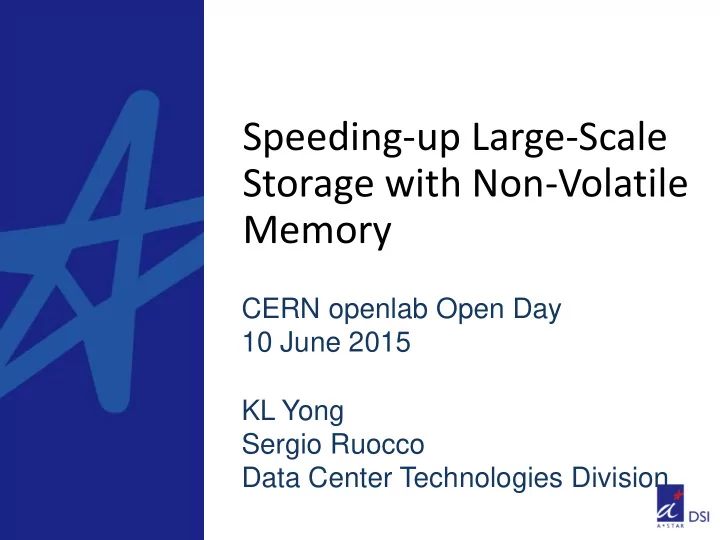

Speeding-up Large-Scale Storage with Non-Volatile Memory CERN openlab Open Day 10 June 2015 KL Yong Sergio Ruocco Data Center Technologies Division
about DSI DSI vision Founded in 1992, DSI’ vision is to be a vital node in a global community of knowledge generation and innovation, nurturing research talents and capabilities for world class R&D in next generation technologies. mission To establish Singapore as an R&D center of excellence in data storage technologies.
Core Competencies • 10Tb/in 2 areal density technologies HARD DISK DRIVE TECHNOLOGIES • Thin Hybrid HDD (0.5TB 2.5”, 5mm, hybrid HDD) • STT-MRAM NON-VOLATILE • ReRAM MEMORIES • Signal Processing & Error Correction • IC Design • NVM System DATA CENTER • Active Hybrid Storage System TECHNOLOGIES • Big Data Analytics Platform • Data & Storage Security • Nanofabrication ADVANCED • Spintronics CONCEPT & • Plasmonics NANOFABRICATION TECHNOLOGIES • Photo-Electronics • Metamaterials and Small Particle Physics Research
Massive Data Key Challenge for Data Center • CAPEX cost for additional IT Performance equipment - servers, networks and storage Scalability • Driving the energy costs • Larger footprint and space required Security • Increasingly challenging and costly Energy to scale and deliver performance Consumption • Increasing complexity in operating and managing the data center Space • Providing data protection and security for massive amount of data Manageability
Future Data Center Architecture with Emerging Technologies Integration of Software Homomorphic NVM Hybrid Drive Active Drive Managed Security Hard Disk Controller Magnetic Open Media Flow Cache NVM Performance, scalable, secured, energy and cost efficient
Next Generation Non Volatile Memory (NVM) Characteristics of next generation NVM: + high speed ~ DRAM like + data persistent against power loss + byte-addressable (vs 4KB- 512KB blocks) + endurance (~DRAM like) >>> Flash + no refresh cycles/energy Technology Read Write Endurance Read Write Maturity Cycle (V) (V) 6000 μ s 6000 μ s HDD NA 5V, 12V 5V,12V Product (15KRPM) 25 μ s 200 μ s/1.5ms 10 5 SLC Flash 2 15 Product (Program/Erase) (1000x for MLC) 10 16 DRAM <10ns <10ns 1.8 2.5 Product 10 15 STT-MRAM 2-20ns 2-20ns 0.7 + 1 Advanced Development
NVM Research in DSI: Device to System NVM Controller NVM Device NVM-based Systems Materials & I/O Flow, Scheduling, NVM File System Structure Buffering Signal System, Memory & Process Wear Leveling Processing Storage Stacks Programming Model, IC Erasure Coding Language & Toolchains Integration NVM Systems FPGA and firmware Cluster
Next Generation Non-Volatile Memory 8msec 50usec 2usec 8000 To fully exploit its performance, the hardware architecture and OS stacks including programming model – applications, languages, compilers/VMs, run-time libraries, middleware,... – must change
NVM Software Programming Model Application Application POSIX Direct memory NVM Programming Primitives load/store File System & Lib NVM New programming model for NVM provides data persistence integrated into the application programs: Byte-addressable Load/Storage access without demand paging Memory performance
CERN EOS NameSpace Metadata operations (create, rename, move, delete 9.6M etc.) are sped-up by in-memory NameSpace, with a growing RAM footprint of 100+ GBs files 93M files Disk-based logs enable consistent reconstruction of NameSpace to recover after any hw & sw faults 4.4M client 1 files 7.4M catalog or files client 2 68M NameSpace EOS files node 100GB+ RAM client 100 50+ PB experimental data in 150M+ files across 5 experiments (nodes): ATLAS, CMS, LHCB, ALICE… client 1000+ disk-based log Node availability critical for the continued operation of thousands of clients
Challenges: Availability and Consistency Read-only One of the challenges is the consistent FailOver journaling of metadata updates between client 1 memory and disk logs; but also across failures of the NS service, the hardware client 2 or power. Reconstructing a 100GB+ Catalog can Failed & take even 10 minutes, disrupting client’s client 100 recovering work. Reconstruction is not IO-bound but CPU- client 1000+ bound because data structures trade-off disk-based log lookup speed against insert s peed.
Proposed Solution: EOS Catalog in Non-Volatile Memory Store the instance of the EOS Catalog in Non-Volatile Memory. NVM-based Catalog is persistent, fault-tolerant, and always consistent. No more slow reconstructions from logs . client 1 Persistent Read-Write client 2 Catalog Node Non-Volatile Memory client 100 client 1000+ Failed & Volatile memory recovering disk-based log
of Enabling Storage Technologies
Recommend
More recommend